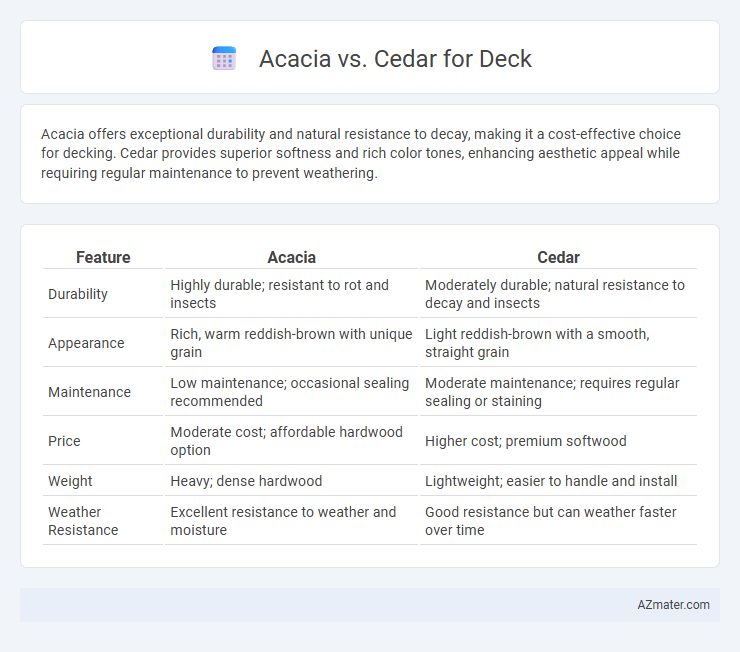Acacia offers exceptional durability and natural resistance to decay, making it a cost-effective choice for decking. Cedar provides superior softness and rich color tones, enhancing aesthetic appeal while requiring regular maintenance to prevent weathering.
Table of Comparison
| Feature | Acacia | Cedar |
|---|---|---|
| Durability | Highly durable; resistant to rot and insects | Moderately durable; natural resistance to decay and insects |
| Appearance | Rich, warm reddish-brown with unique grain | Light reddish-brown with a smooth, straight grain |
| Maintenance | Low maintenance; occasional sealing recommended | Moderate maintenance; requires regular sealing or staining |
| Price | Moderate cost; affordable hardwood option | Higher cost; premium softwood |
| Weight | Heavy; dense hardwood | Lightweight; easier to handle and install |
| Weather Resistance | Excellent resistance to weather and moisture | Good resistance but can weather faster over time |
Introduction to Acacia and Cedar Decking
Acacia and cedar are popular choices for decking due to their natural durability and aesthetic appeal. Acacia wood is dense, hard, and highly resistant to wear, making it ideal for high-traffic outdoor areas, while cedar offers natural resistance to rot and insect damage with a softer, aromatic texture. Both woods provide excellent weather resistance, with acacia showcasing rich, warm tones and cedar prized for its light, reddish hues and smooth finish.
Durability Comparison: Acacia vs Cedar
Acacia wood offers higher hardness and greater resistance to scratches and dents compared to cedar, making it a more durable choice for deck construction. Cedar contains natural oils that provide excellent resistance to rot, decay, and insect damage, but it is softer and more prone to surface wear. Both woods require regular maintenance to preserve longevity; however, Acacia's dense grain structure typically results in a longer-lasting deck under heavy foot traffic and harsh weather conditions.
Weather Resistance and Lifespan
Acacia wood offers strong weather resistance with natural oils that protect against moisture and insect damage, making it durable for outdoor decks with a typical lifespan of 25 to 30 years when properly maintained. Cedar is renowned for its excellent weather resistance due to its natural tannins that resist decay and insect attacks, often lasting 15 to 20 years in deck applications with regular upkeep. Both woods perform well in varied climates, but Acacia tends to provide a longer lifespan under harsh weather conditions, while Cedar offers a lighter, more aromatic option with good stability.
Appearance and Color Variations
Acacia wood showcases rich, warm tones ranging from golden brown to dark reddish hues, often highlighted by striking grain patterns that add character to deck surfaces. Cedar offers a lighter, more uniform color palette, typically featuring pale pinks, reds, and soft browns with a naturally smooth texture that ages gracefully to a silvery-gray patina. Both woods enhance outdoor decks with distinct aesthetic qualities, where Acacia's vibrant contrasts create a bold visual statement while Cedar provides a subtle, classic look.
Maintenance Requirements
Acacia wood decks require regular sealing and staining every 1-2 years to maintain their durability and vibrant color, as the wood is prone to weathering and cracking. Cedar decks naturally resist decay and insect damage, reducing the frequency of maintenance, but still benefit from annual cleaning and occasional sealing to preserve their appearance. Both woods demand timely attention to prevent moisture damage, with cedar offering slightly lower upkeep due to its natural oils and resistance properties.
Cost and Affordability
Acacia wood offers a more budget-friendly option for decking compared to cedar, with prices typically 20-30% lower per board foot. While cedar is renowned for its natural rot resistance and aesthetic appeal, its higher cost can impact overall project affordability. Homeowners prioritizing cost-efficiency often choose Acacia for its durability and lower price point in outdoor decking applications.
Environmental Impact and Sustainability
Acacia wood is highly renewable and fast-growing, making it an environmentally sustainable choice for decking due to its ability to quickly replenish natural resources. Cedar, while slower growing, is naturally resistant to decay and pests, reducing the need for chemical treatments that can harm ecosystems. Both woods offer eco-friendly options, but acacia's rapid growth cycle and certification availability often provide a stronger sustainability profile.
Workability and Installation
Acacia wood offers superior workability for decking due to its dense grain and uniform texture, enabling smooth cutting, sanding, and fastening with standard tools. Cedar, known for its lightweight and softer fibers, allows easier handling and quicker installation but may require more careful fastening to avoid splitting. Both woods provide durable decking options, though Acacia's hardness can demand more effort during installation compared to the more manageable cedar boards.
Pros and Cons of Acacia Decking
Acacia decking offers exceptional durability and a rich, warm color that enhances outdoor aesthetics, making it a popular choice for decks exposed to varying weather conditions. Its natural resistance to rot and insects reduces maintenance costs, but Acacia requires regular sealing to prevent fading and surface wear compared to cedar, which tends to have better dimensional stability. Despite the higher hardness of Acacia providing greater scratch resistance, it can be heavier and more challenging to work with than the lighter, more easily milled cedar wood.
Pros and Cons of Cedar Decking
Cedar decking offers natural resistance to rot, decay, and insect attacks, making it a durable choice for outdoor use with minimal chemical treatment. Its lightweight and stable properties reduce warping and splitting compared to other woods, contributing to easier installation and long-lasting performance. However, cedar requires regular maintenance, including sealing and staining, to preserve its color and protect against weathering and surface wear over time.

Infographic: Acacia vs Cedar for Deck
 azmater.com
azmater.com